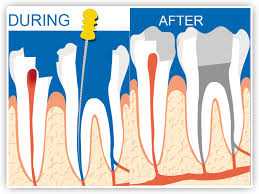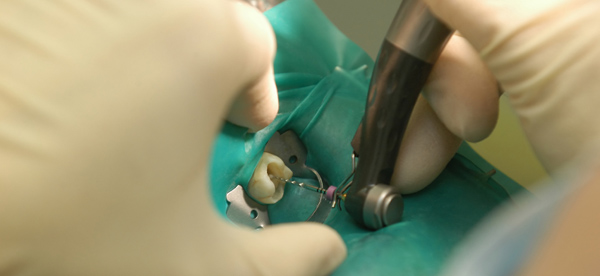Root Canal Treatment
Root canal therapy refers to the process by which a dentist treats the inner aspects of a tooth, specifically that area inside a tooth that is occupied by its pulp tissue. It involves removal of the microbes, degenerated nerve tissue and other organic debris from within the root canal and filling it with an inert material. It can be done either as a single sitting procedure or in multiple visits that is determined on a case to case basis.
We at Dr.Anil Da Silvas Dental Clinics believe in a conservative approach to dentistry and recommend root canal therapy to save cariously exposed (Nerve Exposed) teeth that otherwise would need extraction, thus maintaining the natural tooth and in turn preventing jaw bone loss.
Necessary cases for root canal requirement
There are many things that can damage the pulp or nerve of the tooth. The following are some of the more common reasons for needing root canal treatment.
Pain: A toothache is the most common symptom of needing a root canal. The pain that comes from a tooth needing a root canal is fairly specific. If the tooth is still alive, the affected person will experience extreme sensitivity to heat or cold, and that sensitivity will continue even after the hot or cold stimulus is taken away from the tooth. The tooth may start to hurt spontaneously,in the middle of the night, or sometimes when the patient isn't even using the affected tooth to eat or drink. The pain can progress to a very severe generalized headache that may cause the person to even forget what initially caused the pain. If the tooth is dead and has become abscessed, the patient will feel pain when he or she chews or puts pressure on the tooth. An abscess may or may not produce swelling or bleeding around the tooth, and sometimes it causes significant swelling of the cheek, jaw, or throat. If this swelling is noticed, treatment needs is urgent -- even it that means going to urgent care or the emergency room of a hospital.Many other conditions of the mouth can masquerade as a toothache. Therefore, it is very important, when feeling some pain around a tooth, to get a thorough examination with pulp vitality testing by a licensed dentist for a proper diagnosis.
Abscess: If a tooth has become abscessed, it will require a root canal. An abscess forms when the pulp of the tooth dies and a pus pocket forms around the end of the root.The pus accumulates in an area of dead nerve tissue that is infected with bacteria.Sometimes the abscess will form a bump that looks like a pimple on the outside of the gums. A patient may even notice pus draining from the pimple or notice a bad taste in his or her mouth.An abscess that is left untreated will continue to grow and infect the bone around the root of the tooth. It may spread into surrounding bone and tissues. In rare cases, people have died from infections that started from a tooth abscess.Although antibiotics can help keep the infection from spreading, the only way to remove the infection completely is by performing root canal treatment and cleaning out all the dead tissue and bacteria inside the pulp chamber and root canals.
Deep cavity: If tooth decay extends deep into the tooth and reaches the pulp, the pulp will become infected with bacteria. When this happens, it will either become inflamed and painful or it will die and become decayed tissue. Sometimes there will be no pain, but the only way the dentist can get all of the tooth decay out of the tooth is by performing a root canal and removing the nerve that has become affected as well.
Trauma: If a tooth is hit with great force, the nerve can be severed at the end of the root and eventually die. This could happen immediately after the traumatic incident, or it may happen over many years following the trauma.
Fracture: A tooth that has become fractured may need a root canal if the fracture extends deep into the tooth and reaches the pulp. If a tooth has fractured in a way that doesn't leave very much tooth structure left above the gum line for a crown or other restoration, a root canal may need to be performed so a post and can be placed down the canal of the tooth to help retain the restoration.
Resorption: Root resorption is a condition whereby the tooth structure dissolves away as a reaction to injury, trauma, tooth replantation, or aggressive tooth movement during orthodontics. Not all of the causes of resorption are fully understood. If the defect starts from the outside of the root and goes inward, it is called external root resorption. If the tooth dissolves from the middle or inside of the tooth and progresses toward the outside, it is classified as internal resorption. In either situation, the resorption can invade the pulp canal and the vital nerve and blood vessels contained therein. If this occurs, the tooth needs root canal treatment in combination with specialized conditioning and repairing of the defect quickly before the resorption destroys more tooth structure. The defect is typically repaired with a material called mineral trioxide aggregate (MTA). Resorption usually causes no pain and is usually only diagnosed using X-rays.
Root canals can also be done if the case permits.










